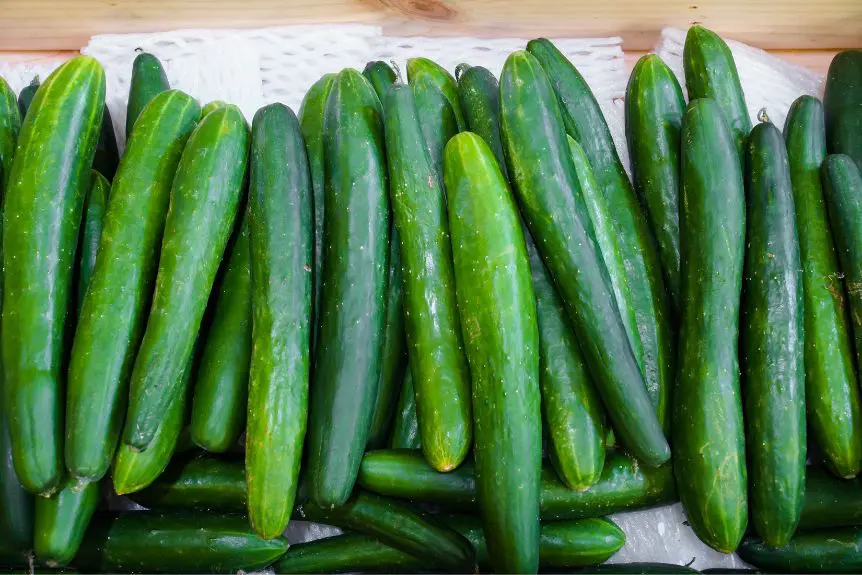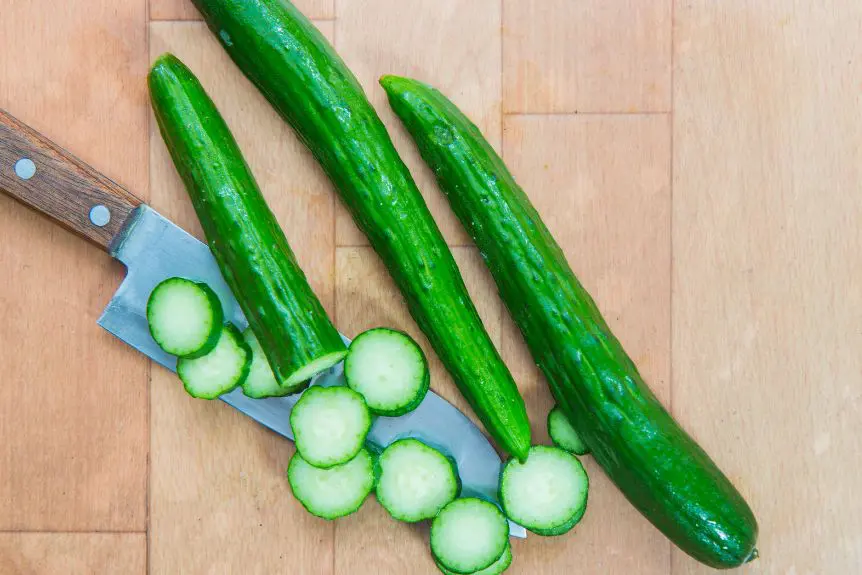Japanese cucumbers are a feast for the eyes, with their vibrant green color and crisp freshness. But have you ever wondered about the meticulous cultivation and harvesting practices that contribute to their unique qualities?
From selecting the perfect seeds to harvesting at just the right time, every step is taken to ensure that these cucumbers reach your table at the peak of their freshness.
Not only are they visually appealing, but they also offer a range of nutritional benefits and can be used in a variety of culinary creations.
Whether you’re a food enthusiast or simply curious about the journey of these cucumbers from seed to plate, this article will delve into their cultivation methods, nutritional value, and exciting culinary applications.
And don’t worry, we’ll also reveal the secrets to storing and preserving their freshness so that you can enjoy that crisp, clean taste whenever you desire. Get ready to discover the fascinating world of Japanese cucumbers!


Understanding Japanese Cucumbers’ Unique Freshness
While Japanese cucumbers are renowned for their crunch, it’s their unparalleled freshness that truly sets them apart in culinary uses.
You’ll find that their thin, tender skin and minimal seeds allow them to retain a crisp texture and a clean, refreshing flavor that’s simply unmatched. This unique freshness isn’t just a matter of taste; it’s a pivotal characteristic that you can leverage to elevate your dishes.
To harness this freshness, it’s essential you understand what makes these cucumbers stand out.
Unlike their thicker-skinned cousins, Japanese cucumbers have a higher water content, which contributes to their crispness and refreshing taste. This quality makes them an ideal ingredient for salads, sushi, and pickles, where their texture and flavor can truly shine.
Incorporating Japanese cucumbers into your culinary repertoire allows you to control the freshness and quality of your dishes. Whether you’re slicing them thin for a delicate garnish or chopping them for a vibrant salad, their distinct freshness will be a testament to your commitment to quality.
Remember, the key to maximizing their unique attributes lies in their preparation and immediate use, ensuring that their crispness and flavor enhance every bite.
Cultivation and Harvesting Practices
Exploring how Japanese cucumbers are grown and harvested shows a detailed process that keeps them uniquely fresh and crisp. Precision and timing are key in cultivating these slender, crunchy veggies.
To start, you must select a well-draining soil enriched with organic matter, ensuring a fertile ground for the seeds. Planting them in raised beds or rows allows for better air circulation and easier access during harvesting.
You’ll need to monitor the plants closely, providing consistent watering and mulching to maintain moisture levels and suppress weeds.
Japanese cucumbers thrive in full sun, requiring at least six to eight hours of direct sunlight daily. As the vines develop, you’ll want to support them with trellises or stakes, promoting vertical growth that facilitates air flow and reduces disease risk.
Harvesting is a test of your attentiveness. You’ll pick the cucumbers when they’re about 8 to 10 inches long, ensuring they’re still tender and at their peak of freshness. Frequent harvesting encourages the plants to produce more fruit, maximizing your yield.
This hands-on approach guarantees you’ll enjoy the crispest, most flavorful cucumbers, perfect for your culinary creations.
Nutritional Benefits Explored
Beyond their crisp texture and versatility in the kitchen, Japanese cucumbers offer a wealth of nutritional benefits that can boost your health. You’ll find that incorporating these slender, refreshing vegetables into your diet isn’t just about adding a crunchy element to your dishes; it’s a strategic move towards better health management.
Rich in vitamins, particularly Vitamin K, which is essential for blood clotting and bone health, Japanese cucumbers help you take control of your nutritional intake without adding significant calories.
They’re also packed with water, making them an excellent choice for staying hydrated, especially important during those hot summer months or after a strenuous workout.
Furthermore, the dietary fiber in Japanese cucumbers aids in digestion and can help you maintain a healthy weight, as it keeps you feeling full longer. This is particularly beneficial if you’re watching your weight or managing your dietary intake.
The antioxidants present, such as beta-carotene and flavonoids, combat inflammation and fend off free radicals, adding a layer of protection against chronic diseases.
Embracing Japanese cucumbers in your daily diet means you’re not just enjoying their fresh taste but actively contributing to your body’s well-being. It’s a proactive step toward a healthier lifestyle, with every crunchy bite.


Culinary Uses and Recipes
Having explored the health benefits of Japanese cucumbers, let’s now turn our attention to how you can incorporate these versatile veggies into your meals with some creative recipes.
You’ve got the power to transform your diet, adding both nutrition and exciting flavors effortlessly.
Start with a simple Japanese cucumber salad. Slice cucumbers thinly, toss them with a dash of rice vinegar, soy sauce, sesame oil, and a sprinkle of sugar for a refreshing side dish. You control the balance of flavors, adjusting each ingredient to suit your taste.
For something with a bit more substance, why not whip up a cucumber sushi roll? You’ll need sushi rice, nori sheets, and fillings of your choice (think avocado, crab meat, or tofu for a vegetarian option).
Lay out a nori sheet, spread a thin layer of rice, add your sliced cucumbers and other fillings, then roll it up tightly. You decide the combination, making each roll a personalized culinary adventure.
Lastly, consider cucumber-infused water for a hydrating treat. Simply add sliced cucumbers to a pitcher of water, letting it chill for a few hours. The result? A detoxifying drink that’s both refreshing and under your control.
Storing and Preserving Freshness
To maintain your Japanese cucumbers’ crispness and flavor, it’s crucial to store them properly. First off, you’ll want to avoid washing them before storage; this step is key to preventing premature spoilage.
Instead, wrap each cucumber individually in a dry paper towel to absorb any moisture and place them in a plastic bag. This method helps in retaining their freshness and extends their shelf life.
Next, find the perfect spot in your fridge. Japanese cucumbers prefer the crisper drawer, where the temperature is slightly higher than the rest of the fridge but cooler than room temperature. This specific environment keeps them fresh without freezing them, which can cause damage to their texture.
You’ve also got the power to decide how long they stay fresh. By checking on them regularly, you can remove any that start to show signs of spoilage, preventing the spread to others. If you’re planning to use them within a few days, keeping them at the front of the fridge will remind you to use them while they’re at their best.
With these steps, you’ll master the art of keeping your Japanese cucumbers fresh, ensuring they’re always ready for your culinary creations.
Conclusion
Now you know all about the unique freshness of Japanese cucumbers, their careful cultivation, their health benefits, and some tasty ways to include them in your meals. However, opinions vary, and some might argue that cucumbers from other regions are equally fresh and delicious.
What do you think? Have you had the chance to try Japanese cucumbers and compare them to others? We’d love to hear your thoughts and experiences in the comments below!
Remember, the key to keeping cucumbers crisp is proper storage. Now, it’s your turn to experiment. Try incorporating cucumbers into your meals, whether in salads, pickles, or refreshing snacks. You’ll not only add a crunch to your dishes but also a boost of nutrition.
Enjoy exploring the fresh taste of Japanese cucumbers, and don’t forget to share your opinion with us!





Konnichiwa! (Hello!) I'm Pat Tokuyama, a Japanese tofu cookbook author, who travels for music, food, and adventure. If you like Japanese tea, checkout some of the newestorganic japanese tea, matcha bowls and noren and more!
** Curious about the Plant Based Japanese Cooking Club? ** Learn more here!